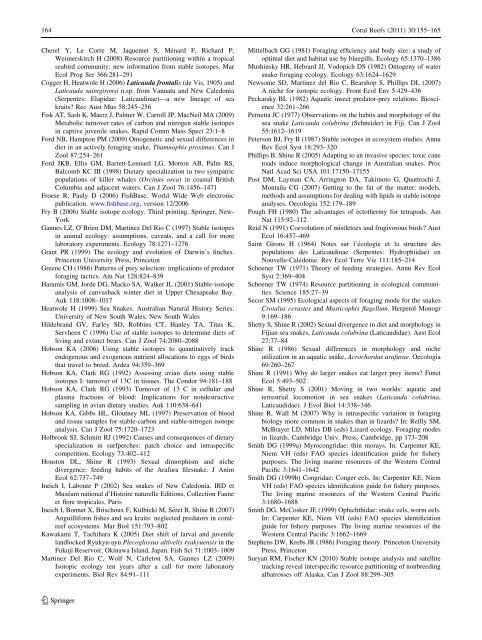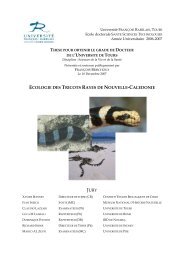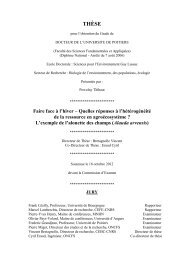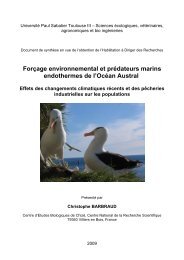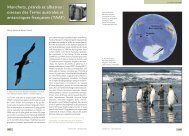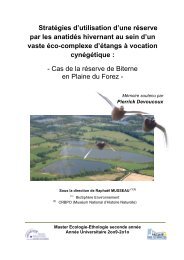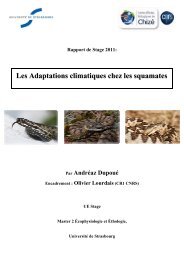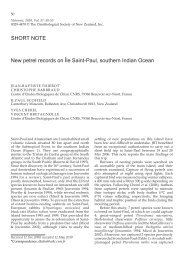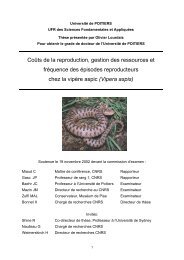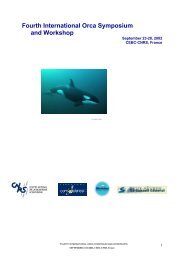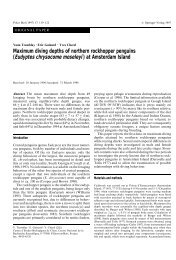Isotopic signatures, foraging habitats and trophic ... - Cebc - CNRS
Isotopic signatures, foraging habitats and trophic ... - Cebc - CNRS
Isotopic signatures, foraging habitats and trophic ... - Cebc - CNRS
Create successful ePaper yourself
Turn your PDF publications into a flip-book with our unique Google optimized e-Paper software.
164 Coral Reefs (2011) 30:155–165<br />
Cherel Y, Le Corre M, Jaquemet S, Ménard F, Richard P,<br />
Weimerskirch H (2008) Resource partitioning within a tropical<br />
seabird community: new information from stable isotopes. Mar<br />
Ecol Prog Ser 366:281–291<br />
Cogger H, Heatwole H (2006) Laticauda frontalis (de Vis, 1905) <strong>and</strong><br />
Laticauda saintgironsi n.sp. from Vanuatu <strong>and</strong> New Caledonia<br />
(Serpentes: Elapidae: Laticaudinae)—a new lineage of sea<br />
kraits? Rec Aust Mus 58:245–256<br />
Fisk AT, Sash K, Maerz J, Palmer W, Carroll JP, MacNeil MA (2009)<br />
Metabolic turnover rates of carbon <strong>and</strong> nitrogen stable isotopes<br />
in captive juvenile snakes. Rapid Comm Mass Spect 23:1–8<br />
Ford NB, Hampton PM (2009) Ontogenetic <strong>and</strong> sexual differences in<br />
diet in an actively <strong>foraging</strong> snake, Thamnophis proximus. Can J<br />
Zool 87:254–261<br />
Ford JKB, Ellis GM, Barrett-Lennard LG, Morton AB, Palm RS,<br />
Balcomb KC III (1998) Dietary specialization in two sympatric<br />
populations of killer whales (Orcinus orca) in coastal British<br />
Columbia <strong>and</strong> adjacent waters. Can J Zool 76:1456–1471<br />
Froese R, Pauly D (2006) FishBase. World Wide Web electronic<br />
publication. www.fishbase.org, version 12/2006<br />
Fry B (2006) Stable isotope ecology. Third printing. Springer, New-<br />
York<br />
Gannes LZ, O’Brien DM, Martinez Del Rio C (1997) Stable isotopes<br />
in animal ecology: assumptions, caveats, <strong>and</strong> a call for more<br />
laboratory experiments. Ecology 78:1271–1276<br />
Grant PR (1999) The ecology <strong>and</strong> evolution of Darwin’s finches.<br />
Princeton University Press, Princeton<br />
Greene CH (1986) Patterns of prey selection: implications of predator<br />
<strong>foraging</strong> tactics. Am Nat 128:824–839<br />
Haramis GM, Jorde DG, Macko SA, Walker JL (2001) Stable-isotope<br />
analysis of canvasback winter diet in Upper Chesapeake Bay.<br />
Auk 118:1008–1017<br />
Heatwole H (1999) Sea Snakes. Australian Natural History Series.<br />
University of New South Wales, New South Wales<br />
Hildebr<strong>and</strong> GV, Farley SD, Robbins CT, Hanley TA, Titus K,<br />
Servheen C (1996) Use of stable isotopes to determine diets of<br />
living <strong>and</strong> extinct bears. Can J Zool 74:2080–2088<br />
Hobson KA (2006) Using stable isotopes to quantitatively track<br />
endogenous <strong>and</strong> exogenous nutrient allocations to eggs of birds<br />
that travel to breed. Ardea 94:359–369<br />
Hobson KA, Clark RG (1992) Assessing avian diets using stable<br />
isotopes I: turnover of 13C in tissues. The Condor 94:181–188<br />
Hobson KA, Clark RG (1993) Turnover of 13 C in cellular <strong>and</strong><br />
plasma fractions of blood: Implications for nondestructive<br />
sampling in avian dietary studies. Auk 110:638–641<br />
Hobson KA, Gibbs HL, Gloutney ML (1997) Preservation of blood<br />
<strong>and</strong> tissue samples for stable-carbon <strong>and</strong> stable-nitrogen isotope<br />
analysis. Can J Zool 75:1720–1723<br />
Holbrook SJ, Schmitt RJ (1992) Causes <strong>and</strong> consequences of dietary<br />
specialization in surfperches: patch choice <strong>and</strong> intraspecific<br />
competition. Ecology 73:402–412<br />
Houston DL, Shine R (1993) Sexual dimorphism <strong>and</strong> niche<br />
divergence: feeding habits of the Arafura filesnake. J Anim<br />
Ecol 62:737–749<br />
Ineich I, Laboute P (2002) Sea snakes of New Caledonia. IRD et<br />
Muséum national d’Histoire naturelle Editions, Collection Faune<br />
et flore tropicales, Paris<br />
Ineich I, Bonnet X, Brischoux F, Kulbicki M, Séret B, Shine R (2007)<br />
Anguilliform fishes <strong>and</strong> sea kraits: neglected predators in coralreef<br />
ecosystems. Mar Biol 151:793–802<br />
Kawakami T, Tachihara K (2005) Diet shift of larval <strong>and</strong> juvenile<br />
l<strong>and</strong>locked Ryukyu-ayu Plecoglossus altivelis ryukyuensis in the<br />
Fukuji Reservoir, Okinawa Isl<strong>and</strong>, Japan. Fish Sci 71:1003–1009<br />
Martinez Del Rio C, Wolf N, Carleton SA, Gannes LZ (2009)<br />
<strong>Isotopic</strong> ecology ten years after a call for more laboratory<br />
experiments. Biol Rev 84:91–111<br />
123<br />
Mittelbach GG (1981) Foraging efficiency <strong>and</strong> body size: a study of<br />
optimal diet <strong>and</strong> habitat use by bluegills. Ecology 65:1370–1386<br />
Mushinsky HR, Hebrard JJ, Vodopich DS (1982) Ontogeny of water<br />
snake <strong>foraging</strong> ecology. Ecology 63:1624–1629<br />
Newsome SD, Martinez del Rio C, Bearshop S, Phillips DL (2007)<br />
A niche for isotopic ecology. Front Ecol Env 5:429–436<br />
Peckarsky BL (1982) Aquatic insect predator-prey relations. Bioscience<br />
32:261–266<br />
Pernetta JC (1977) Observations on the habits <strong>and</strong> morphology of the<br />
sea snake Laticauda colubrina (Schneider) in Fiji. Can J Zool<br />
55:1612–1619<br />
Peterson BJ, Fry B (1987) Stable isotopes in ecosystem studies. Annu<br />
Rev Ecol Syst 18:293–320<br />
Phillips B, Shine R (2005) Adapting to an invasive species: toxic cane<br />
toads induce morphological change in Australian snakes. Proc<br />
Natl Acad Sci USA 101:17150–17155<br />
Post DM, Layman CA, Arrington DA, Takimoto G, Quattrochi J,<br />
Montaña CG (2007) Getting to the fat of the matter: models,<br />
methods <strong>and</strong> assumptions for dealing with lipids in stable isotope<br />
analyses. Oecologia 152:179–189<br />
Pough FH (1980) The advantages of ectothermy for tetrapods. Am<br />
Nat 115:92–112<br />
Reid N (1991) Coevolution of mistletoes <strong>and</strong> frugivorous birds? Aust<br />
Ecol 16:457–469<br />
Saint Girons H (1964) Notes sur l’écologie et la structure des<br />
populations des Laticaudinae (Serpentes: Hydrophiidae) en<br />
Nouvelle-Calédonie. Rev Ecol Terre Vie 111:185–214<br />
Schoener TW (1971) Theory of feeding strategies. Annu Rev Ecol<br />
Syst 2:369–404<br />
Schoener TW (1974) Resource partitioning in ecological communities.<br />
Science 185:27–39<br />
Secor SM (1995) Ecological aspects of <strong>foraging</strong> mode for the snakes<br />
Crotalus cerastes <strong>and</strong> Masticophis flagellum. Herpetol Monogr<br />
9:169–186<br />
Shetty S, Shine R (2002) Sexual divergence in diet <strong>and</strong> morphology in<br />
Fijian sea snakes, Laticauda colubrina (Laticaudidae). Aust Ecol<br />
27:77–84<br />
Shine R (1986) Sexual differences in morphology <strong>and</strong> niche<br />
utilization in an aquatic snake, Acrochordus arafurae. Oecologia<br />
69:260–267<br />
Shine R (1991) Why do larger snakes eat larger prey items? Funct<br />
Ecol 5:493–502<br />
Shine R, Shetty S (2001) Moving in two worlds: aquatic <strong>and</strong><br />
terrestrial locomotion in sea snakes (Laticauda colubrina,<br />
Laticaudidae). J Evol Biol 14:338–346<br />
Shine R, Wall M (2007) Why is intraspecific variation in <strong>foraging</strong><br />
biology more common in snakes than in lizards? In: Reilly SM,<br />
McBrayer LD, Miles DB (eds) Lizard ecology. Foraging modes<br />
in lizards. Cambridge Univ. Press, Cambridge, pp 173–208<br />
Smith DG (1999a) Myrocongridae: thin morays. In: Carpenter KE,<br />
Niem VH (eds) FAO species identification guide for fishery<br />
purposes. The living marine resources of the Western Central<br />
Pacific 3:1641–1642<br />
Smith DG (1999b) Congridae: Conger eels. In: Carpenter KE, Niem<br />
VH (eds) FAO species identification guide for fishery purposes.<br />
The living marine resources of the Western Central Pacific<br />
3:1680–1688<br />
Smith DG, McCosker JE (1999) Ophichthidae: snake eels, worm eels.<br />
In: Carpenter KE, Niem VH (eds) FAO species identification<br />
guide for fishery purposes. The living marine resources of the<br />
Western Central Pacific 3:1662–1669<br />
Stephens DW, Krebs JR (1986) Foraging theory. Princeton University<br />
Press, Princeton<br />
Suryan RM, Fischer KN (2010) Stable isotope analysis <strong>and</strong> satellite<br />
tracking reveal interspecific resource partitioning of nonbreeding<br />
albatrosses off Alaska. Can J Zool 88:299–305


